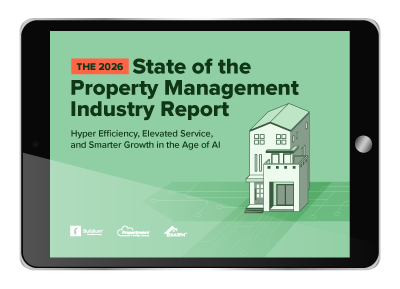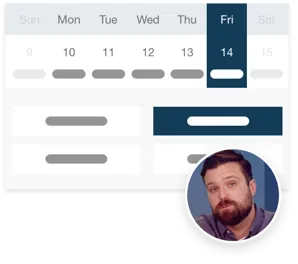As a property manager, few things are more frustrating than signing a new client, only to lose them a few months later. It’s not just the lost revenue. It’s the time and money poured into marketing that doesn’t fully materialize, forcing you to restart the acquisition cycle again and again.
To avoid this, you must nail down your ideal customer profile (ICP). A clear ICP can reduce churn, boost your return on marketing spend, and help align your and your customers’ business goals.
In this post, we’ll walk through what an ICP is, the benefits of defining one, and the four steps to build yours. We’ll also show how technology can make the process easier and more accurate, helping you retain the right clients and grow your business for the long term.
What Is a Property Management Customer Profile?
In property management, a customer profile is a detailed description of an owner client. It often includes information about their rental portfolio’s size, type, and investment strategy.
An ideal customer profile is similar, except that it’s a description of the type of client you most want to work with (even if you don’t currently). The purpose of an ICP is to help you target your marketing efforts and avoid signing contracts with clients who are a bad fit.
For example, your ICP might be a regional investor who owns 20-30 multifamily units across several properties. They may already have some systems in place but struggle with consistent reporting, tenant communications, and compliance at scale. This makes them an ideal candidate for a professional property management company.
Benefits of Knowing Your Ideal Customer Profile
Defining and adapting your strategies to your ICP benefits your business in many ways. Here are some of the most important advantages:
Stronger alignment with clients
When you attract clients whose needs match your services, you set the stage for smoother, more productive relationships. This alignment builds trust and reduces the friction that can lead to dissatisfaction.
Reduced churn
Clients who fit your ICP are more likely to stay long-term because your services directly address their goals and challenges. That stability reduces the costly cycle of replacing lost revenue with new business.
Higher return on marketing spend
Targeting your outreach toward your ICP ensures that your budget goes further by focusing on the prospects most likely to convert and stay. This lets you scale your marketing without wasting resources on poor-fit leads.
Stronger alignment internally
From sales and marketing to operations, a clear ICP gives your entire team a shared vision of the customer you serve best. That consistency aligns your messaging, onboarding, and service delivery with each other so that they all reinforce the same strategy.
Better customer service
Knowing your ICP allows you to anticipate client needs, tailor your communication, and provide a more personalized experience. The result is greater client satisfaction and stronger word-of-mouth referrals.
Increased profitability
Serving the right clients boosts retention and optimizes your marketing spend, which leads to higher margins. Over time, this focus on the “right” customers compounds into a more sustainable and profitable business model.
How to Determine Your Ideal Customer Profile
To determine your ideal customer profile, focus on these practical steps designed to clarify who you serve best and how to build stronger, longer-lasting relationships:
Step 1: Analyze Your Current Customer Base
First, analyze your existing and past clients to identify patterns in who stays and who goes. That way, you can refine your ICP by who generates the most long-term business.
Start by segmenting your customers into high-value, average, and low-value groups based on how much revenue they generate for your property management business.
From there, look for common traits among your best customers across portfolio size/type, investment strategy, contract length, etc. Then do the same for customers who leave after a short period.
Over time, you can detect patterns that can help shape your ICP.
Step 2: Conduct Market Research
Market research can validate whether your ICP is sustainable and scalable for your business. For instance, while you may find large multifamily owners to be the most profitable clients, you may not want to focus on them if your market doesn’t have many apartment buildings.
Here’s how to keep up with the latest market trends:
- Subscribe to industry reports. For example, Buildium’s The 2026 Property Management Industry Report covers the latest economic and demographic trends driving rental demand.
- Consult local professionals. Networking with real estate agents, contractors, and other local experts can give you on-the-ground insights into rental demand and client needs.
- Analyze competitor websites. Reviewing competitors’ messaging, services, and customer focus can help you spot market gaps and refine your own positioning.
- Run customer surveys. Gathering direct feedback from clients can reveal what they value most in you and where you can improve your service.
Step 3: Develop Customer Personas
Once you’ve nailed down your ICP, it’s time to give it a face by developing some customer personas, i.e., creating fictional characters who represent your ICP. This helps your sales and marketing teams visualize the customer and tailor their messaging.
For example, if your ICP is short-term rental (STR) owners with 10-30 units in Miami, you might develop three different personas who meet these criteria. Give each a name, such as Bob, Sarah, and John, and then define their personal characteristics across:
- Demographics (e.g., their gender, age, and income)
- Psychographics (e.g., their values, goals, and concerns)
- Pain points (e.g., vacancy rates, maintenance headaches, compliance issues)
From there, you can even create artistic renderings with short bios to share internally. This helps focus your team on the right leads and ensures consistency across marketing efforts.
Step 4: Align with Business Goals and Values
Finally, before committing to an ICP or customer personas, double check they meet your long-term business goals. For example, if your ultimate goal is to manage 1,000 multifamily units, avoid signing on single-family rental owners, even if they’d be a good fit otherwise.
To keep your clients personas in alignment with your long-term business strategy:
- Clarify your business goals (e.g., portfolio size, revenue targets) and your business values (e.g., transparency, integrity, teamwork).
- Identify which customer types align with those goals and values.
- Stop pursuing customers who don’t align with those goals and values.
By gradually aligning your ICP and long-term goals, you can achieve them sooner.
Utilizing Technology to Enhance ICP Analysis and Support
Instead of analyzing your ICP manually by juggling data on spreadsheets, take advantage of purpose-built tech. Here’s an overview of the tools that can define your ICP faster and more accurately.
CRM Systems to Identify Your ICP
Customer relationship management (CRM) platforms are software tools that organize your customer and lead information in a central place.
Because your CRM already consolidates customer data, you can mine it for patterns. For example, you can analyze your clients’ communication histories, service usage, and engagement levels to refine your ICP.
Pro tip: LeadSimple is a full-fledged CRM platform that was built for property managers and integrates seamlessly with Buildium. Give it a try if you don’t use a CRM yet or want to upgrade.
Data Analytics for Smarter Decisionmaking
Take your ICP analysis to the next level with data analytics. For example, with Buildium’s analytics and business performance features, you can get deep insights into your customers and how their portfolios stack up against past performance and industry benchmarks.
In fact, when paired with machine learning and artificial intelligence, data analytics can even help you predict which owners are likely to renew contracts, which services drive the highest retention rates, and other powerful business insights that can further refine your ICP.
Adapting Services Based on Your ICP Data
As you learn more about clients who fit your ICP, it’s important to adapt to their preferences. For instance, if your top clients value fast response times or frequent maintenance updates, tailor your services accordingly.
Keep in mind that your ICP is rarely static. It could change over time. That’s why it’s important to keep a pulse on your clients’ wants and needs by requesting and welcoming feedback. Property managers who adapt their services accordingly tend to have higher retention rates.
Pro tip: Dedicated tools such as Steady can help you offer an owner benefit package to attract your target clients. The package includes rental protection, legal assistance, market- and asset-level reporting, and more.
The Bottom Line
Ultimately, defining your ideal customer profile isn’t just about avoiding churn. It’s about building stronger, longer-lasting relationships with the right clients. This can boost the profitability of your business and set it up for long-term success.
By analyzing your customer base, conducting market research, creating personas, and leveraging tools like Buildium, you can refine your ICP and adapt your services to it.
Ready to test these strategies with purpose-built tools? Sign up for Buildium’s no-risk 14-day trial, or schedule a demo with a platform expert to see firsthand how it can transform your property management business.
Frequently Asked Questions
What is churn in property management?
Churn refers to the rate at which owner clients end their contracts or stop using your services. High churn is costly because it means constantly spending on marketing and onboarding new clients just to replace lost revenue. Reducing churn helps stabilize cash flow and allows your team to focus on growth rather than replacement.
How do I determine customer churn?
You can determine churn by tracking your client retention rate: the percentage of owner clients who continue working with you over a given period. Look at contract renewals, service usage, and communication patterns. Many property managers also segment clients by tenure to identify which types are most likely to leave. This data can highlight red flags early, giving you the chance to act before a client walks away.
What is an ideal customer profile (ICP), and why is it important for property managers?
An ICP is a description of the type of client that best fits your services — the size of their portfolio, the property types they own, their goals, and even their pain points. Defining your ICP helps you focus on clients who are more likely to stick with you long term. For property managers, that means less churn, better alignment with business goals, and higher profitability.
How can property managers gather data to identify their ideal customer profile?
Most revenue, and compare them with those who left early. Add in market research from industry reports, customer surveys, and competitor analysis. Finally, use CRM platforms like LeadSimple or Buildium’s analytics tools to spot trends that might not be obvious at first glance.
What are the key characteristics to consider when defining an ideal customer profile for property management?
Key characteristics include portfolio size (number of units), property type (single-family, multifamily, short-term rentals), investment strategy, and typical challenges (such as maintenance costs or turnover). You’ll also want to consider how well their goals align with yours — for example, whether they’re focused on growth, stability, or profitability.
What tools or software can property managers use to analyze and develop their ideal customer profile?
Property managers often use CRM systems like LeadSimple to organize client data, along with property management platforms like Buildium for financial and operational reporting. Data analytics tools help reveal which client types are most profitable and which are at risk of churn. Marketplace partners such as Steady Technologies also offer products like the Owner Benefit Package™ that can help attract and retain the right types of clients.
Read more on Uncategorized

